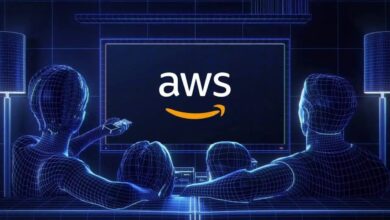AWS Management Console: 7 Powerful Features You Must Know
Welcome to the ultimate guide on the AWS Management Console—a powerful, user-friendly gateway to Amazon Web Services. Whether you’re a beginner or a seasoned cloud engineer, mastering this interface can dramatically boost your efficiency and control over your cloud infrastructure.
What Is the AWS Management Console?

The AWS Management Console is a web-based interface that allows users to interact with Amazon Web Services (AWS) through a graphical user interface (GUI). Instead of relying solely on command-line tools or APIs, users can visually manage their AWS resources, monitor performance, configure services, and troubleshoot issues—all from a single, centralized dashboard.
Core Purpose and Functionality
The primary goal of the AWS Management Console is to simplify cloud management. It abstracts the complexity of managing infrastructure at scale by offering intuitive navigation, real-time monitoring, and quick access to over 200 AWS services such as EC2, S3, Lambda, RDS, and more.
- Provides visual access to AWS services
- Enables point-and-click configuration
- Supports multi-account and multi-region management
How It Compares to CLI and SDKs
While the AWS Command Line Interface (CLI) and Software Development Kits (SDKs) offer automation and scripting capabilities, the Management Console excels in accessibility and ease of use. It’s ideal for exploration, learning, and quick troubleshooting.
“The AWS Management Console is the front door to the cloud for millions of developers and IT professionals worldwide.” — AWS Official Documentation
Key Features of the AWS Management Console
The AWS Management Console isn’t just a dashboard—it’s a feature-rich environment designed to enhance productivity, security, and visibility across your cloud ecosystem. Let’s dive into its most impactful capabilities.
Unified Service Access
One of the standout features of the AWS Management Console is its centralized service catalog. From the AWS homepage, users can search for and launch any service with just a few clicks.
- Search bar with autocomplete for fast service discovery
- Service categories grouped by function (Compute, Storage, Networking, etc.)
- Recent services list for quick re-access
This unified access reduces the learning curve for new users and streamlines workflows for experienced ones.
Real-Time Monitoring and Dashboards
The console integrates deeply with Amazon CloudWatch, providing real-time metrics, logs, and custom dashboards. You can monitor CPU usage, network traffic, disk I/O, and application performance without leaving the interface.
- Pre-built dashboards for EC2, RDS, and Lambda
- Custom widget creation for tailored monitoring
- Alarm setup directly from metric graphs
For example, you can view your EC2 instance’s CPU utilization in real time and set up an alarm if it exceeds 80%—all within the same screen.
Integrated Security and Compliance Tools
Security is baked into the AWS Management Console. It provides direct access to AWS Identity and Access Management (IAM), AWS Shield, AWS WAF, and AWS Config, enabling users to enforce policies, audit configurations, and respond to threats quickly.
- View IAM user permissions and activity logs
- Enable MFA (Multi-Factor Authentication) with one click
- Run compliance checks using AWS Trusted Advisor
These tools help organizations meet regulatory standards like GDPR, HIPAA, and SOC 2.
Navigating the AWS Management Console Interface
Understanding the layout of the AWS Management Console is crucial for efficient navigation. The interface is clean, responsive, and highly customizable, but it can be overwhelming at first glance.
Top Navigation Bar
The top bar contains essential global controls:
- Region Selector: Switch between AWS regions (e.g., US East, EU West) to manage resources locally.
- Support Center: Access technical support, billing help, and service health status.
- Account Menu: Manage billing, security credentials, and AWS Organizations.
Changing regions affects which resources you can see—always verify your selected region.
Services Menu and Favorites
The left-hand sidebar houses the Services menu, which lists all available AWS offerings. You can:
- Pin frequently used services as favorites
- Filter services by category (e.g., Machine Learning, Developer Tools)
- Use the search bar to jump to a service instantly
For example, typing “S3” immediately takes you to the Amazon S3 console, where you can manage buckets and objects.
Dashboard Customization
Users can personalize their AWS Management Console homepage by adding widgets for specific services, recent activities, or cost forecasts. This customization enhances productivity by surfacing the most relevant information upfront.
- Add CloudWatch widgets for key metrics
- Display AWS Budgets for cost tracking
- Pin service-specific dashboards (e.g., Lambda functions)
Setting Up Your First AWS Management Console Session
Getting started with the AWS Management Console is straightforward, but following best practices ensures a secure and efficient setup.
Creating an AWS Account
To access the AWS Management Console, you need an AWS account. Visit aws.amazon.com/console and click “Create an AWS Account.” You’ll need:
- A valid email address
- A credit card for identity verification
- Basic contact and organization details
AWS offers a Free Tier with limited usage of many services for 12 months, perfect for learning and small projects.
Configuring IAM Users and Roles
Never use the root account for daily operations. Instead, create IAM users with least-privilege permissions.
- Go to IAM in the AWS Management Console
- Create a new user with programmatic and console access
- Assign policies like
PowerUserAccessor custom roles
This practice enhances security and enables auditability of user actions via AWS CloudTrail.
Enabling Multi-Factor Authentication (MFA)
MFA adds an extra layer of security. In the IAM section of the AWS Management Console:
- Select your user
- Click “Add MFA”
- Use a virtual MFA app (like Google Authenticator) or a hardware key
Once enabled, users must enter a time-based code during login, significantly reducing the risk of unauthorized access.
Managing AWS Resources via the Console
The AWS Management Console is designed to make resource management intuitive. Whether you’re launching a virtual server or configuring a database, the console guides you through each step.
Launching an EC2 Instance
Amazon Elastic Compute Cloud (EC2) is one of the most commonly used services. To launch an instance:
- Navigate to EC2 in the AWS Management Console
- Click “Launch Instance”
- Choose an Amazon Machine Image (AMI), instance type, and configure security groups
- Review and launch
The console provides a step-by-step wizard, reducing the chance of misconfiguration.
Creating and Managing S3 Buckets
Amazon S3 is used for object storage. To create a bucket:
- Go to S3 in the AWS Management Console
- Click “Create bucket”
- Enter a unique name and select a region
- Configure settings like versioning, encryption, and public access
The console warns you about public access risks, helping prevent data leaks.
Using AWS Lambda for Serverless Computing
The AWS Management Console simplifies serverless function deployment. You can:
- Create a new Lambda function with a few clicks
- Upload code directly or use container images
- Set up triggers from S3, API Gateway, or CloudWatch Events
All configurations are visual, making it easy to build event-driven architectures without deep CLI knowledge.
Security and Access Control in the AWS Management Console
Security is not an afterthought in AWS—it’s integrated into every layer of the Management Console.
Understanding IAM Policies and Permissions
Identity and Access Management (IAM) is central to securing your AWS environment. The AWS Management Console provides a visual policy editor to help define granular permissions.
- Attach managed policies (e.g.,
AmazonS3ReadOnlyAccess) - Create custom JSON policies for fine-tuned access
- Test policies using the IAM Policy Simulator
For example, you can allow a developer to read S3 buckets but not delete them.
Monitoring User Activity with CloudTrail
AWS CloudTrail logs all actions taken in the AWS Management Console. You can:
- View who made changes and when
- Track API calls across services
- Set up alerts for suspicious activities
This audit trail is essential for compliance and incident response.
Using AWS Organizations for Multi-Account Management
For enterprises, AWS Organizations allows you to manage multiple AWS accounts from a single console. You can:
- Apply Service Control Policies (SCPs) across accounts
- Consolidate billing
- Automate account creation
This reduces administrative overhead and enforces governance at scale.
Cost Management and Optimization Tools
One of the most powerful aspects of the AWS Management Console is its ability to help you control and optimize cloud spending.
Using AWS Budgets and Cost Explorer
The AWS Management Console includes built-in tools to track and forecast costs:
- AWS Budgets: Set custom spending limits and receive alerts when thresholds are exceeded.
- Cost Explorer: Visualize spending trends, identify cost drivers, and forecast future expenses.
You can break down costs by service, region, or tag, enabling precise cost allocation.
Identifying Idle or Underutilized Resources
The console helps detect wasted spending. For example:
- EC2 instances running at less than 5% CPU utilization
- Unattached EBS volumes
- S3 buckets with no recent access
Using Trusted Advisor, you can get recommendations to terminate or resize underused resources.
Reserved Instances and Savings Plans
The AWS Management Console shows potential savings from Reserved Instances (RIs) and Savings Plans. You can:
- View eligible services for reservation
- Compare on-demand vs. reserved pricing
- Purchase RIs directly from the console
These commitments can reduce costs by up to 72% compared to on-demand pricing.
Best Practices for Using the AWS Management Console
To get the most out of the AWS Management Console, follow these proven best practices.
Use Tags for Resource Organization
Tagging resources (e.g., with Environment=Production or Owner=TeamX) enables better organization, cost tracking, and automation.
- Apply tags during resource creation
- Use consistent naming conventions
- Leverage tags in IAM policies and cost reports
Leverage the AWS Console Mobile App
AWS offers a mobile app that mirrors key console functionalities. You can:
- Monitor CloudWatch alarms
- Approve IAM access requests
- Receive service health notifications
This keeps you connected to your cloud environment even when away from your desk.
Enable AWS CloudShell for Quick CLI Access
CloudShell is a browser-based shell available directly in the AWS Management Console. It provides:
- Pre-authenticated access to AWS CLI
- No need to install or configure local tools
- Access to common Linux commands and scripting
It’s perfect for quick troubleshooting or running scripts without leaving the console.
Troubleshooting and Support in the AWS Management Console
Even with the best practices, issues can arise. The AWS Management Console provides robust tools to diagnose and resolve problems.
Using the AWS Health Dashboard
The AWS Service Health Dashboard shows the real-time status of all AWS services in your region. If a service is degraded, you’ll see an alert here before users report issues.
- View ongoing incidents and scheduled changes
- Subscribe to RSS feeds or SNS notifications
- Access detailed incident reports
Accessing Support Center and Trusted Advisor
The Support Center in the AWS Management Console is your hub for help:
- Create and manage support cases
- Chat with AWS engineers (for Business and Enterprise plans)
- Access documentation and forums
Trusted Advisor offers automated checks across five categories: cost optimization, performance, security, fault tolerance, and service limits.
Debugging with CloudWatch Logs and Metrics
When an application fails, CloudWatch Logs let you inspect log files from EC2, Lambda, or containers. You can:
- Search logs using filters
- Create metric filters to turn log data into CloudWatch metrics
- Set up alarms based on log patterns (e.g., “ERROR” count)
This integration makes the AWS Management Console a powerful debugging tool.
Advanced Tips and Hidden Features
Beyond the basics, the AWS Management Console has several advanced features that power users rely on.
Using the AWS Console Search Bar Like a Pro
The global search bar isn’t just for services—it can find resources by name, ID, or tag. For example, typing “web-server-prod” might return EC2 instances, S3 buckets, and CloudFront distributions matching that term.
- Use wildcards and partial matches
- Filter results by resource type
- Jump directly to resource configuration pages
Customizing the Console with Themes and Shortcuts
While the AWS Management Console doesn’t support full theme customization, you can:
- Switch to dark mode (if supported by your browser/theme)
- Create browser bookmarks for deep links
- Use keyboard shortcuts (e.g., ‘s’ to focus search)
These small tweaks improve usability over time.
Integrating with Third-Party Tools via Console Links
AWS allows you to add custom links to the console for third-party tools like Datadog, New Relic, or Splunk. This creates a unified operations hub without leaving AWS.
- Configure custom links in service settings
- Pass resource context (e.g., instance ID) to external tools
- Streamline incident response workflows
What is the AWS Management Console?
The AWS Management Console is a web-based user interface that allows users to manage Amazon Web Services through a graphical dashboard. It provides access to over 200 AWS services, enabling users to configure, monitor, and troubleshoot cloud resources without using command-line tools.
Is the AWS Management Console free to use?
Yes, the AWS Management Console itself is free to use. You only pay for the AWS services (like EC2, S3, or Lambda) that you provision and consume through the console. There is no additional charge for accessing the console interface.
How do I secure my AWS Management Console access?
To secure your AWS Management Console, always use IAM users instead of the root account, enable Multi-Factor Authentication (MFA), apply least-privilege permissions, and monitor activity with AWS CloudTrail. Regularly review access logs and rotate credentials.
Can I manage multiple AWS accounts from one console?
Yes, using AWS Organizations and the AWS Management Console, you can manage multiple AWS accounts from a single control plane. You can switch between accounts using role switching or consolidate billing and apply policies across all accounts.
What are the alternatives to the AWS Management Console?
Alternatives include the AWS CLI (Command Line Interface), AWS SDKs for programming languages, Infrastructure as Code tools like AWS CloudFormation or Terraform, and third-party cloud management platforms like Datadog or CloudHealth.
The AWS Management Console is more than just a dashboard—it’s a powerful, secure, and intuitive gateway to the entire AWS ecosystem. From launching your first EC2 instance to monitoring global application performance and optimizing costs, the console puts control at your fingertips. By mastering its features, following security best practices, and leveraging built-in tools like CloudWatch, IAM, and Cost Explorer, you can maximize both efficiency and reliability in the cloud. Whether you’re a beginner or a cloud expert, the AWS Management Console remains an indispensable tool in your toolkit.
Recommended for you 👇
Further Reading:









